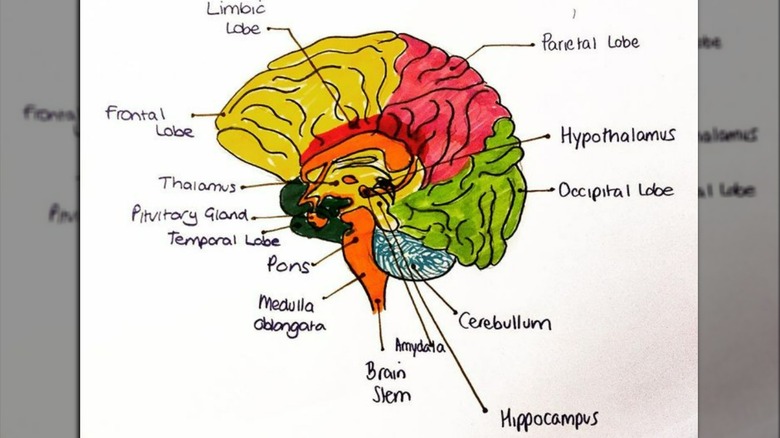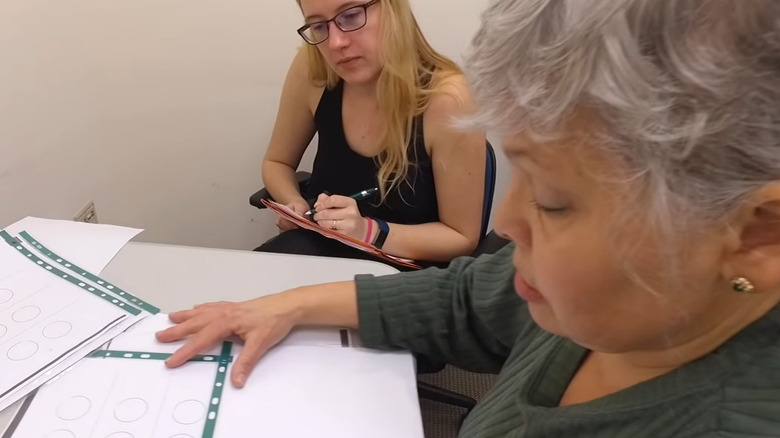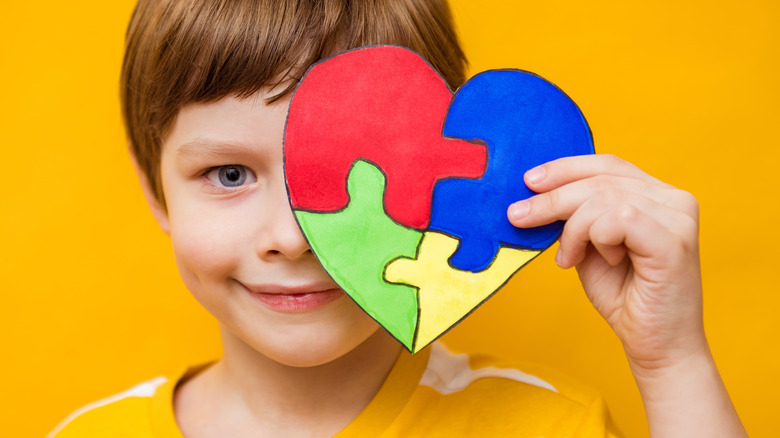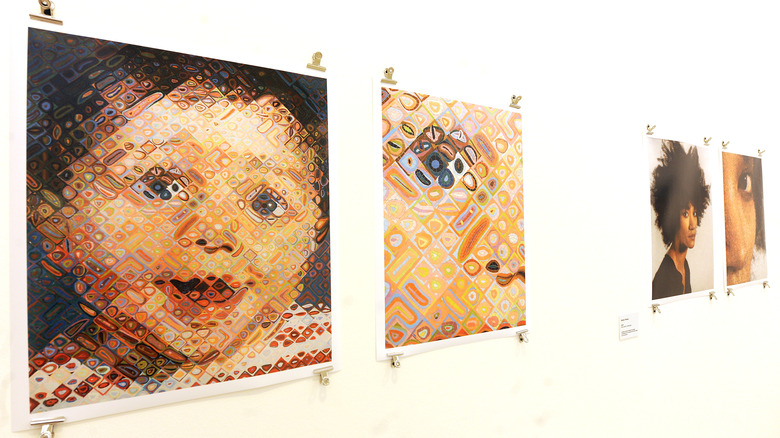Brad Pitt's Prosopagnosia Explained
Although his is one of the most recognizable faces in the world, Brad Pitt has a difficult time recognizing other people by face — so difficult, in fact, that he believes it may rise to the level of the neurological condition, prosopagnosia. That's what he told Esquire in 2013 and GQ in 2022.
Prosopagnosia is the clinical term for an inability to recognize faces that can't be attributed to visual impairment, according to Healthline. With prosopagnosia, it's not that one cannot remember the person; rather, it's that one cannot connect their knowledge of the person to the face that their eyes are seeing. Prosopagnosia is sometimes referred to as face blindness, although that term is somewhat misleading; prosopagnosia isn't a visual impairment at all, but rather a dysfunction in the way the brain processes visual data.
Pitt hasn't been formally diagnosed with prosopagnosia, but he believes his difficulty recognizing faces is consistent with prosopagnosia. "Brad Pitt won't remember you.... Even if you've had what he calls 'a real conversation,' your face will start fading from his memory as soon as you walk away," is how Esquire put it. "So many people hate me because they think I'm disrespecting them," Pitt told the outlet, but apparently, it has nothing to do with respect. In fact, his difficulty recognizing faces has been the source of considerable discomfort for him over the years, per GQ. Apparently, that's common among people with prosopagnosia, as you're about to find out.
What is prosopagnosia?
Prosopagnosia is a form of agnosia — an inability to recognize sensory stimulus, where such disability is not attributable to issues with memory, attention, language, or unfamiliarity (via the National Institutes of Health's StatPearls). In prosopagnosia (a portmanteau of the Greek words for "face" and "lack of knowledge," per the National Institute of Neurological Disorders and Stroke), that stimulus is the human face.
Prosopagnosia was first identified in 1947 by German neurologist Joachim Bodamer while studying patients who'd suffered brain injuries during World War II and subsequently complained of difficulties with facial recognition in one form or another (via The Atlantic). One such patient found he couldn't recognize and distinguish between other peoples' facial expressions. Another couldn't assemble facial features together to form a cohesive face. In the years that followed, other presentations of prosopagnosia have been identified, including an inability to recognize faces one is already familiar with (including one's own), and an inability to distinguish between new faces (i.e., the faces of people with whom one is not familiar all appear largely the same), via the NINDS.
Prosopagnosia is rarely diagnosed, but around 2% of the general population may experience some degree of difficulty in recognizing faces, according to prosopagnosia expert Dartmouth professor Bradley Duchaine (via the Handbook of Face Perception). To the extent prosopagnosia is underdiagnosed, it may be because many who have it may not recognize that their experience of faces is different from that of other people, per The Atlantic.
What causes prosopagnosia?
Societal awareness of prosopagnosia leaves something to be desired, according to Brad Pitt, who told GQ that few believe his failure to recognize faces isn't within his control. Although some level of prosopagnosia is believed to affect 1 in 50 people (per Time), it has, at least until recently, been treated as something of a niche topic within neurology, with only around 100 cases ever even having been documented in medical literature only by 2013 (via The Atlantic, which points out that it didn't have a name until 1947).
Nevertheless, scientists believe they have pinpointed the place in the brain that's responsible for facial recognition, or the part of the brain that makes sense of the visual stimuli received by the eyes (which collectively adds up to the cognitive recognition of a face). That part of the brain is known as the fusiform gyrus, according to various imaging studies which demonstrated that this area of the brain lights up when someone is shown a picture of a face, per ScienceDirect. The fusiform gyrus is a fold adjacent to both the brain's occipital and temporal lobes, according to a 2020 study published in Scientific Reports.
Prosopagnosia is believed to be caused by abnormalities in the right fusiform gyrus, just above the right ear (via Science). Those abnormalities may be present from birth, which is known as developmental prosopagnosia. They may also develop subsequently, which is considered acquired prosopagnosia.
Acquired versus developmental prosopagnosia
A diagnosis of acquired prosopagnosia refers to clinically significant difficulty recognizing faces that develops in someone who has never before had difficulty with facial recognition, per Faceblind. Acquired prosopagnosia can be caused by any number of conditions and injuries that affect the brain. These include Alzheimer's disease and other forms of dementia, brain tumors (both cancerous and non-cancerous), traumatic head injury, stroke, seizure, brain infection (e.g., encephalitis), and exposure to certain toxins, including carbon monoxide, according to the Cleveland Clinic.
Because prosopagnosia was first identified in World War II veterans with brain injuries (via The Atlantic), scientists used to believe that all prosopagnosia was acquired, according to the NHS. Most diagnosed cases of prosopagnosia are in fact acquired, which is to say they result from illness or accident, according to the late Dr. Oliver Sacks, a neurologist and expert on prosopagnosia, as well as someone in whom developmental prosopagnosia was diagnosed (via The New Yorker). Nevertheless, acquired prosopagnosia is extremely rare. By contrast, developmental prosopagnosia is more common but less frequently diagnosed.
According to The Atlantic, studies suggest that many people who have never been diagnosed with prosopagnosia may be walking around with some degree of face recognition dysfunction. Most of these cases are attributable to developmental prosopagnosia, which is sometimes referred to as congenital prosopagnosia. A diagnosis of developmental prosopagnosia refers to clinically significant difficulty recognizing faces that has been present since early childhood — even if it's diagnosed only later.
Is it possible to have prosopagnosia without realizing it?
It does not appear that Brad Pitt has actually been diagnosed with prosopagnosia, so it is impossible to say whether the difficulty he has recognizing faces is developmental versus acquired. However, whether developmental or acquired, prosopagnosia may be difficult to recognize in oneself, according to Faceblind. That may go a long way toward explaining why Brad Pitt only began talking publicly about his difficulty recognizing faces in 2013 — the year he told Esquire that he believed he might have prosopagnosia. By then, it had already been some undisclosed number of years since Pitt first read about prosopagnosia and began to suspect that his difficulty recognizing faces (which he may have been dealing with for many years) might rise to the level of a neurological deficit.
In other words, it's entirely possible that Brad Pitt had been dealing with prosopagnosia for some time before he came to recognize that perhaps, not everyone has as much difficulty recognizing faces as he does. In fact, he might have been dealing with the condition throughout his entire life. According to the authors of a 2018 study published in Scientific Reports, many people remain oblivious to their own developmental prosopagnosia until middle age or even older. Likewise, despite how acquired prosopagnosia tends to come on suddenly and acutely, it's not always readily apparent to those who develop it, according to Faceblind.
What are the signs you may have prosopagnosia?
Prosopagnosia isn't simply forgetting some faces some of the time, according to Healthline. It's a consistent issue that affects the sufferer every single day of their lives. Even then, it can present in different forms. For example, in apperceptive prosopagnosia, there is difficulty recognizing and decoding facial expressions, according to the Cleveland Clinic. In associative prosopagnosia, the difficulty is in recognizing people by face. In extreme cases of associative prosopagnosia, there is difficulty even recognizing the faces of one's immediate family; there may even be difficulty in recognizing one's own face, according to Test My Brain.
The challenges experienced by people with prosopagnosia can go well beyond awkward social situations, though. In fact, as much as people with prosopagnosia feel their deficit in social situations, the most common complaint of those with the disorder is difficulty keeping track of characters in television shows and films, per Faceblind. Additionally, people with prosopagnosia may find it difficult, if not impossible, to picture in their minds the faces of those whom they love.
Another hallmark of prosopagnosia is compensating for difficulty recognizing faces by employing some of the cognitive coping mechanisms that we'll be discussing below in relation to how prosopagnosia is treated (via Faceblind). This may be one of the more difficult signs to recognize in oneself, however, as coping mechanisms frequently are, as a general matter (per Psychology Today).
How is prosopagnosia diagnosed?
How prosopagnosia is diagnosed depends upon the circumstances. If you have noticed a decline in your ability to recognize faces or facial expressions, your healthcare provider may suspect acquired prosopagnosia, which can be further assessed via imaging studies, per Dr. Salman Azhar, a neurologist at Lenox Hill Hospital in New York (via Atlanta Journal-Constitution). Virtually all acquired prosopagnosia presents with a lesion or other structural abnormality in the fusiform gyrus, according to the late neurologist Oliver Sacks (via The New Yorker). If a lesion or other structural abnormality is observed, then further testing may be required to determine the underlying cause, of which there are many possibilities (including stroke, brain injury, tumor, seizure disorder, or infection), via the Cleveland Clinic.
Developmental prosopagnosia is more difficult to diagnose because whatever it is that may be causing the deficit is unlikely to show up in imaging studies, according to Dr. Azhar. Accordingly, if, like Brad Pitt, you have a history of failing to recognize faces or facial expressions and think it may rise to the level of prosopagnosia, your healthcare provider may refer you to a neurologist for a full assessment of your facial recognition faculties, including your ability to recognize the faces of famous people, to memorize and later pick out faces previously unknown to you, and to extrapolate data from face regarding age, gender, and affect. Per Healthline, getting to an accurate developmental prosopagnosia diagnosis may be difficult, but your doctor's your best bet.
Prosopagnosia can cause mental pain and anguish
Brad Pitt has feelings about his struggles with recognizing faces that should be familiar, because they belong to people with whom Pitt is familiar. This is essentially how Pitt describes his experience with what he believes is the neurological condition prosopagnosia (he has not been officially diagnosed, but believes his symptoms fit). That's something he made abundantly clear during interviews with Esquire and GQ. To wit, Pitt feels concerned that people may mistake what he believes is a bona fide neurological deficit (i.e., prosopagnosia) for snobbery and self-absorption on his part, when in fact, that deficit happens to be a significant source of disappointment and shame for Pitt.
None of this is surprising, of course, when you consider the complications that MedicineNet identifies as some of the common sequelae of prosopagnosia. These include depression, anxiety, lack of self-confidence, and difficulties in both developing and maintaining interpersonal relationships. According to the Cleveland Clinic, negative emotions associated with socializing lead many with prosopagnosia to simply refrain from socializing altogether. As the National Institute of Neurological Disorders and Stroke points out, prosopagnosia can be debilitating from a social standpoint. Pitt's face blindness has caused him so much discomfort that he's taken to staying home perhaps more than his career in the public eye might otherwise demand, as he told Esquire during a 2013 interview. "You meet so many damned people," he explained. "And then you meet 'em again."
Is prosopagnosia an inherited disorder?
Because acquired prosopagnosia requires a medical deus ex machina of sorts, it can't be said to be inheritable — except to the extent that some of the precipitating events and conditions, including stroke, seizure disorder, and Alzheimer's disease, may be inheritable. Developmental (aka congenital) prosopagnosia, on the other hand, may, in fact, run in families, according to Faceblind. As NHS points out, many people with prosopagnosia have at least one first-degree relative with difficulty recognizing faces.
Studies suggest that this has more to do with nature than with nurture, per Faceblind. In fact, researchers have been able to isolate a number of mutations in genetic material that are more common in people who have been diagnosed with prosopagnosia than in members of the general public. That being said, some of these mutations may be spontaneous as opposed to inherited, according to the Cleveland Clinic.
On the other hand, de novo mutations, as these spontaneous mutations are sometimes referred to, do happen to be more common in people diagnosed with developmental prosopagnosia. The National Institute of Neurological Disorders and Stroke concurs in maintaining the fact that developmental prosopagnosia seems to run within families, and suggests developmental prosopagnosia results from an inherited mutation.
Autism is a significant risk factor for prosopagnosia
As discussed above, having a family member with developmental prosopagnosia increases one's risk of being diagnosed with developmental prosopagnosia. At least one study has found that people of German Caucasian descent may be slightly more predisposed to prosopagnosia than other members of the general population (via a 2006 paper published in the Journal of Human Genetics). But one of the most significant risk factors for prosopagnosia is being on the autism spectrum, according to the pediatric mental health professionals at Elemy, who write that approximately 40% of people who are identified as being on the spectrum have symptoms of prosopagnosia. Moreover, about one-quarter of people with prosopagnosia also have autism.
Accordingly, a childhood diagnosis of prosopagnosia could point to an increased risk of autism, according to the National Institute of Neurological Disorders and Stroke, which notes that the experience of prosopagnosia may actually be responsible for some degree of impaired social development in children. On the other hand, the research in this area is still in its early stages. Accordingly, the connection between prosopagnosia and autism is not yet well understood (which is to say there's no way to know at this point which way the causation runs, if it is indeed a matter of causation as opposed to correlation), according to a 2016 article published in Current Biology.
Prosopagnosia often occurs with these other conditions
As a statistical matter, people with autism are at higher risk of being diagnosed with prosopagnosia, according to Elemy. But autism is not the only condition that may co-exist with prosopagnosia. According to a 2016 article published in Current Biology, developmental prosopagnosia is one example of the category of conditions that may be described as neurodevelopmental disorders. These include dyslexia and autism, as well as dyspraxia and dyscalculia. It seems that a diagnosis of one such neurodevelopmental disorder increases the likelihood of diagnosis of another. The study authors take the position that this may reflect nature (genetic factors) or nurture (environmental factors), or some combination of both.
According to the authors of research presented at the 14th Nordic Meeting of Neurology (which took place in Denmark in August 2021), the majority of people with developmental prosopagnosia, which occurs congenitally as opposed to as a consequence of injury or illness, also have at least one of the following comorbidities, all of which are developmental in nature and influence how we learn and process sensory information: "aphantasia, memory problems, synaesthesia, dyslexia, dyscalculia, attention-deficit/hyperactivity disorder, and object agnosia." Specifically, in a study involving 115 people, 57% of those who were considered to have developmental prosopagnosia — based on answers to 20 survey questions designed to identify prosopagnosia — also have one of these aforementioned developmental comorbidities.
Treatment and prognosis for prosopagnosia
According to the late neurologist Oliver Sacks, who suffered from developmental prosopagnosia for as long as he could remember, the condition is chronic and does not get better as we age. As he noted in The New Yorker, given the emotional distress that may accompany living with prosopagnosia, patients "need to be resourceful and inventive in finding strategies for circumventing their deficit."
According to the National Institute of Neurological Disorders and Stroke, there is currently no cure for prosopagnosia, nor any specific treatment protocol. However, research along those lines appears to be in the works. In the meantime, a number of coping strategies may prove helpful to people with face blindness to recognize faces despite their deficit. In fact, some people with prosopagnosia end up developing their own strategies for recognizing people, including focusing on hairstyle, voice, gait, or style of dress, according to the NHS. The issue with these strategies is that there will inevitably be a breakdown in the system (say for example, when someone changes their hairstyle, comes down with a sore throat, or is encountered seated or otherwise out of the usual context).
A 2019 study published in Neuropsychological Rehabilitation suggests that one potentially useful coping strategy may be proactively disclosing one's prosopagnosia to those who might be impacted by it. The challenge is that many with prosopagnosia are reluctant to make such a disclosure, particularly in the workplace.
Other famous people with prosopagnosia
It's hard to imagine how a big celebrity could function in Hollywood with prosopagnosia. But apparently, Brad Pitt makes it work. It's also hard to imagine how one with prosopagnosia might be able to succeed in politics, but former governor of Colorado, John Hickenlooper has done just that, according to CNN. Like Pitt, Hickenlooper is self-diagnosed. Also, like Pitt, Hickenlooper was deep into midlife before he realized his issues with facial recognition might rise to the level of a neurological deficit. Another person in the public eye who has difficulty recognizing faces is actor Stephen Fry. Like Pitt and Hickenlooper, Fry would appear to be self-diagnosed, but unlike Pitt and Hickenslooper, Fry characterizes his prosopagnosia as only slight (via Twitter).
And then there is the artist, Chuck Close. Diagnosed with prosopagnosia while still in kindergarten, Close is famous for his portraits of faces, per Tampa Bay Times. Or, more specifically, enormous canvases consisting of splotches of color and light that add up to an eye, another eye, a nose, a mouth, and possibly, ultimately a face, if you squint at it from a certain angle while standing about six feet back. Indeed, that's the charm. "I don't know who anyone is and essentially have no memory at all for people in real space," Close told the late neurologist and prosopagnosia expert Dr. Oliver Sacks (via The New Yorker). "But when I flatten them out in a photograph, I can commit that image to memory."













